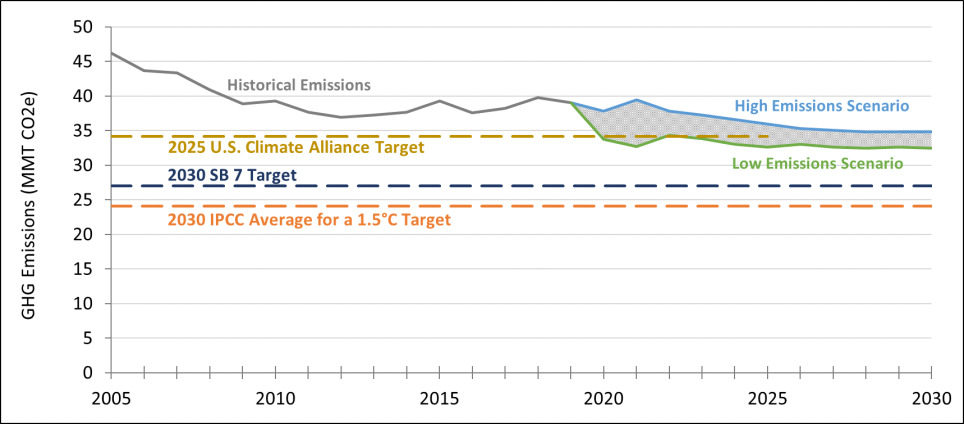Connecticut is poised to lead the way on creating a cleaner and healthier transportation system – if legislators seize the moment to act. This past March, Connecticut Governor Lamont and 11 co-sponsors in the legislature introduced Senate Bill 884, which would give Connecticut the greenlight to implement a major multi-state program aimed at reducing climate pollution from the transportation sector: the Transportation and Climate Initiative Program (TCI-P).
The stakes are high. Passing this bill would make Connecticut among the first states to place a binding limit on climate pollution from transportation, which accounts for 40% of Connecticut’s greenhouse gas emissions. This is critical as EDF analysis found that Connecticut is off track for meeting its statutory 2030 climate target – and will need more policy action.
And beyond making Connecticut a national leader, TCI-P will bring major economic, public health and equity gains to the state.
Here is why Connecticut legislators should waste no time in putting the Transportation and Climate Initiative Program into action.
What is the Transportation and Climate Initiative Program?
In December of last year, Connecticut, along with Massachusetts, Rhode Island, and the District of Columbia, took a huge step forward in tackling climate pollution from transportation, the largest source of greenhouse gas emissions in the U.S. and a significant source of harmful air pollution.
These three states and D.C. committed to participate in the TCI-P, signing on to the regional Memorandum of Understanding to reduce carbon dioxide emissions from motor gasoline and on-road diesel by 26% from 2023 to 2032 and invest in a clean, safe and equitable transportation system.
The TCI-P places a binding limit on carbon dioxide emissions from the combustion of motor gasoline and on-road diesel, which would decline over time to reduce pollution in the region. This binding and declining limit on emissions could kickstart much-needed progress in the transportation sector. While states have made some important progress—particularly in the electric power sector— transformative policies across all the major sources of climate pollution will be essential to achieve President Biden’s new emissions goal of cutting emissions 50-52% by 2030.
The program also puts a price on pollution by requiring fuel suppliers to purchase emission allowances for each ton of CO2 emitted by the fuels they sell. In turn, the proceeds from allowance sales will be invested in programs that further reduce climate pollution from transportation and develop cleaner, safer and more equitable transportation systems. In fact, participation in the TCI-P is expected to raise $89 million in Connecticut in its first year and $1 billion over its first ten years.
This valuable funding can revitalize the state’s transportation system, supporting electric bus purchases, expanded air monitoring, bicycle lanes, pedestrian safety equipment, public transit, electric vehicle infrastructure, access to broadband internet services in rural communities, and measures to calm traffic and reduce congestion. Investments that reduce reliance on fossil fuel powered personal vehicles – such as incentives that lower the cost of purchasing an electric vehicle – can provide cost savings to consumers. A recent EDF analysis found that the lower vehicle and fuel costs of electric vehicles compared to gasoline vehicles will save consumers money over the life of the vehicle.
And across the three states and D.C., TCI-P is expected to generate big wins for the economy and public health: Modeling released by the Transportation and Climate Initiative (TCI) showed that TCI-P will increase GDP by $92 million and disposable income by $69 million across jurisdictions. At the same time, the program is also projected to generate millions of dollars in additional savings through improvements to air quality and safety.
Achieving Connecticut’s climate goals
In 2018, Connecticut established a statutory target to reduce its climate pollution 45% below 2001 levels by 2030. A recent EDF analysis found that Connecticut is off track to achieve this target based on current policies, but policies like the TCI-P can help the state close this emission gap.
By participating in the regional program, Connecticut can demonstrate it is serious about meeting its goals and doing its part to avert the worst impacts of climate change.
Connecticut’s Emissions Gap

In both low and high emissions scenarios (based on recovery from the pandemic), Connecticut is off track for achieving its 2030 goal of reducing emissions 45% below 2001 levels. It’s also not on track to achieve the recommended pathway for 2030 by the Intergovernmental Panel on Climate Change (IPCC): reducing net emissions 45% below 2010 levels.
Investing in a more equitable transportation system
Directing investments raised through TCI-P program to the communities in jurisdictions most overburdened by pollution and underserved by transportation systems – whether those communities are in urban, suburban, or rural areas – can begin to help repair the inequities in the transportation system.
Importantly, the TCI-P jurisdictions have made equity a priority in the draft Model Rule, committing to invest a portion of allowance proceeds in communities overburdened by air pollution and underserved by the transportation system, the establishment of equity advisory bodies, and annual reporting on the program’s equity impacts
It is excellent that Senate Bill 884 includes commitments to equitable program design, and we urge the legislature to prioritize pollution reductions in overburdened communities, incorporate workforce development programs with fair labor standards and diverse hiring, give significant agency to equity advisory boards, and provide equity advisory boards with adequate compensation and technical assistance.
Connecticut and other jurisdictions can ensure air quality improves where communities are currently suffering the most from poor air quality by directing investments to deploy clean technologies in these areas. For example, TCI-P investments can help lower upfront zero-emission vehicle costs through incentives and invest in charging infrastructure in specific communities. Transitioning medium- and heavy-duty vehicles to zero-emissions alternatives is a critical component of a just transition to a low-emissions future as localized pollution from these vehicles disproportionately impacts low- and moderate-income and environmental justice communities that are more likely to be located near freight corridors, ports, bus depots, warehouses and distribution centers and airports. Breathing in these pollutants on a daily basis contributes to higher levels of heart and lung diseases.
The Connecticut Legislature should take this opportunity to lead
Connecticut can set the stage for bold climate leadership in the transportation sector by passing this bill and participating in the TCI-P. And in doing so, it will jumpstart the transition to a cleaner, safer and more equitable transportation solution that lifts up communities that have borne the brunt of pollution for far too long.
With so many reasons to act – and so little time to tackle the climate crisis – Connecticut legislators should put their foot to the pedal on this bill.










